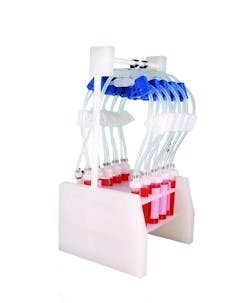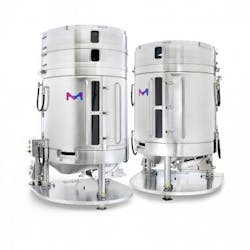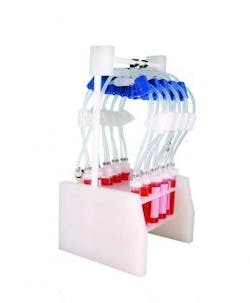MilliporeSigma’s Mobius Power MIX 2,500-liter and 3,000-liter single-use mixers handle difficult-to-mix buffers, cell culture media powders and other pharmaceutical ingredients.
The never-ending quest for speed, sterility and efficiency have made single-use technologies (SUT) one of the most attractive innovations in biomanufacturing. And several drivers in the market are bolstering demand for disposable components.
“There are many dynamics impacting the biopharmaceutical industry, and causing drug manufacturers to take a hard look at how to reduce costs, while increasing their flexibility and productivity,” says Sara Bell, senior marketing manager, Integrated Systems, MilliporeSigma. “Biosimiliars, emerging markets, novel therapies, process intensification and next generation processing are just a few of the market trends driving the increased adoption of single-use technologies.”
Despite the widespread adoption of single-use components, manufacturing equipment vendors have continued to develop new solutions, many of which improve upon earlier innovations, to take SUT to the next level.
Sterility Solutions
Single-use technologies offer several distinct advantages that make them a perfect option for flowpath components, such as tubing. For example, disposable components eliminate the need to clean between unit batch operations, which increases manufacturing efficiency.
“In addition to this efficiency advantage, the wide adoption of single-use products also increases the assurance of sterility in a process by closing all of the unit operations and transfer steps,” says Tim Korwan, director, New Product Development at Avantor. “But, even with any closed system, manufacturers still need to be able to sample or add ingredients to their process pathways, and doing so in a closed aseptic method is critical to the sterility of the process.”
Products such as Avantor’s OmniTop Sample Tubes with OctoCaps improve workflow efficiencies and increase overall process sterility assurance by providing a closed-system solution for biologic sampling. According to Korwan, the design transforms the utility of a conical tube into a closed system with a uniquely designed cap that has multiple port options, including dip tubes.
“This single-use product can be connected easily to existing upstream or downstream bioprocessing equipment by choosing from a wide variety of available weldable tubes or other single-use sterile connectors,” Korwan says. “Added benefits include the option for customizing multi-tube manifolds to match specific process sampling plans and arrangements.”
Avantor’s OmniTop Sample Tubes with OctoCaps improve workflow efficiencies and increase overall process sterility assurance by providing a closed-system solution for biologic sampling.
In the Mix
Innovations in the single-use market have also been driven by earlier technologies.
“The widespread utilization of single-use filter cartridges and capsules paved the way for acceptance of single-use bags and assemblies,” Bell says. “The speed and flexibility of deployment coupled with a reduction in capital costs are the key drivers pushing industry adoption of SUT.”
In particular, Bell says that mixing has become one of the fastest growing single-use applications due to time savings and the reduced risk of contamination. In addition, single-use equipment gives manufacturers flexibility and allows them to batch the same quantities in a smaller footprint.
Last year, MilliporeSignma unveiled its new Mobius Power MIX, which handles difficult-to-mix buffers, cell culture media powders and other pharmaceutical ingredients. According to the company, the 2,500- or 3,000-liter mixers incorporate proprietary NovAseptic technology traditionally used in stainless steel mixers, saving time and enabling more efficient single-use mixing.
But despite the widespread prevalence of single-use mixers, there are still improvements with ease-of-use that vendors have recently sought to address.
According to Kevin Mullen, senior product manager, Single-Use Technologies, Thermo Fisher Scientific, single-use mixer operators have been requesting customized mixer interfaces to improve how they measure and log important data such as pH, conductivity, mass, temperature and pressure. An updated interface would also make mixers easier to operate.
“Many simple or complex processes using mixers currently require operators’ full attention to perform,” Mullen explains. “Time critical unit operations including temperature or pH shits heavily depend on operator accuracy and repeatability.”
To address this challenge, Thermo Fisher has developed a new Touchscreen Console for HyPerforma single-use mixers that the company says offers a cost-effective, user-friendly interface that does not require the expertise of an automation engineer to use. The console also provides state-of-the-art process monitoring and automation capabilities.
“The Touchscreen Console will help users semi-automate their formulation, pH or saline titrations, temperature shifts, and viral inactivation processes,” Mullen says. “This allows users to program their HyPerforma single-use mixer for a process and trust that the measurements are accurate, precise, and provide some controlling features.”
The new console also showcases an example of how different technologies — such as single-use, sensors, analytics and automation — are continuing to converge, giving manufacturers improved process yield, economics, quality and speed.
“Intensified, connected and continuous processing is on the horizon, which will allow drug manufacturers to develop and bring new products to market faster and more cost-effectively than ever before,” Bell says.


